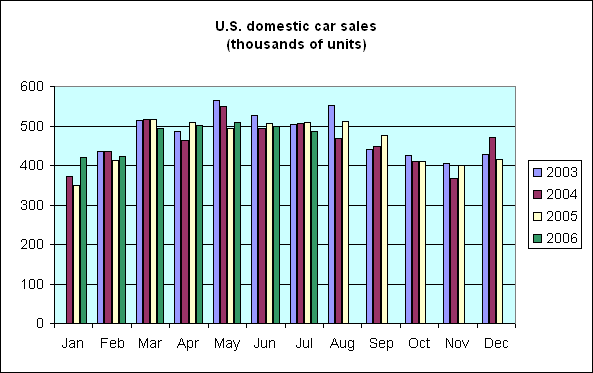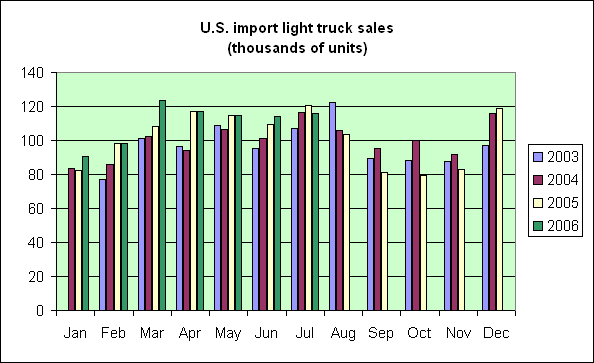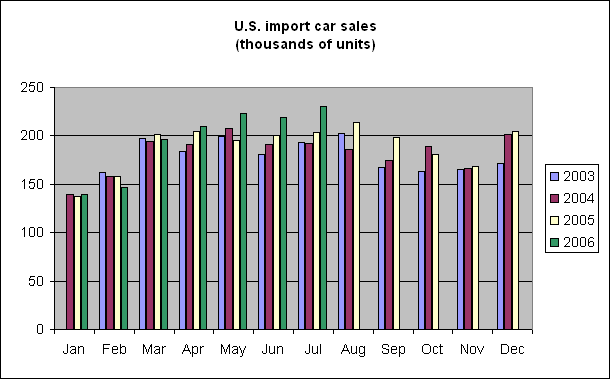The Big 3 U.S. automakers continue to get a little less big.
 |
U.S. auto sales plummet, declare the headlines. Ford led the retreat with their light truck sales (a category that includes the now less-fashionable SUVs) for July down 45% from last year. Of course, those July-to-July comparisons are particularly misleading due to the enormous sales spike that resulted from last year’s discount programs at GM and Ford. Still, the number of domestic light trucks sold for each month since gas prices came back up in March has been lower than for the corresponding months of either 2004 or 2003, averaging 7% below the 2004 figures.
Domestic car sales, which did not share in the wild performance in the summer of 2005, exhibit a more modest declining trend.
 |
| Quarter | Motor vehicles and parts | Residential fixed investment |
|---|---|---|
| 2005:Q1 | -0.29 | +0.63 |
| 2005:Q2 | +0.50 | +1.11 |
| 2005:Q3 | +0.38 | +0.43 |
| 2005:Q4 | -1.51 | -0.06 |
| 2006:Q1 | 0.60 | -0.02 |
| 2006:Q2 | -0.11 | -0.40 |
Though this is not what one would prescribe for an economy on its way down, it does not approach the magnitude of what we saw last fall. Domestic light truck sales in October and November of 2005 were down 20% from their values of 2003. That was a big enough shock to contribute -1.5% to total GDP growth (at an annual rate) for 2005:Q4. By contrast, the BEA reckons that the current slump in domestic autos subtracted a mere 0.1% from the 2006:Q2 growth rate.
By itself, the current slump in autos is not enough to derail U.S. economic growth. Unfortunately, it isn’t by itself. Whereas residential construction had contributed a full percent to last year’s 2005:Q2 GDP growth rate, the housing slump subtracted a bit less than half a percent from this year’s 2006:Q2.
That, too, is not a big enough number to bring the whole economy down. But one could easily imagine the problems in both autos and housing growing significantly in the months ahead. And if they do, we may have run out of excuses to ignore these sore spots.
And how about imports, you ask? Imported light trucks are holding their own,
 |
and car imports are doing very nicely, thank you:
 |
But idling previously productive American labor and capital, and replacing some of the lost output with more imports, is not going to help in terms of the very immediate challenge of maintaining output at its potential level.
Technorati Tags: macroeconomics,
autos,
recessions
Is a Toyota built in Kentucky an import or a domestic? I gather from the commentary on the charts that you count it as an import. To the extent that a job is transferred from Michigan to Kentucky or Tennessee, it is hard to see this as a big problem, unless you happen to be a Ford or GM shareholder, or a line worker.
Rather than the import shift, I think the larger GNP impact comes from the trend towards smaller cars from light trucks. Much less profitable for the car makers, less credit creation for the retail lenders, and a couple thousand less pounds of materials per vehicle. On the other hand, less fuel consumption and lower loan payments means more disposable income for other goods.
By the way, if sales of 5 million light trucks were replaced by sales of 5 million sedans, overall fuel consumption for those vehicles would drop by about 1 billion gallons per annum (200 gallons each per annum), or about 100,000 bbl per day of oil. Do that for 30 years or so and you’re talking real impact!
Donald, Wardsauto reports July 2006 light truck sales as 773,703 units, which they break down as 658,061 domestic and 115,642 imports. I don’t see a further breakdown for the Wardsauto data, but Motor Intelligence has a similar total figure of 777,608 units. This they break down as 257,705 imp. brand light trucks (which I would take to include your Kentucky Toyotas) and 121,352 imp. source truck, which appears comparable to the Wardsauto number simply labeled “imports”.
Of course, there’s a related tricky issue as to tracing the original source of all the components even of the domestic vehicles.
By the way, I completely agree about the need to make the conversion from light trucks back to cars, and welcome that trend. My specific concern has always been that I’d prefer to see that as a gradual process rather than a sudden lurch that can lead to significantly unemployed resources. Whether it’s even possible to make that whole adjustment smoothly is an open question. But, if it’s not smooth, it raises the probability of a recession, which is the point I’m addressing here.
On the other hand July auto sales were 17.2 M (SAAR) vs 16.3 in June — a 5.8% rise.
So it depends on how you look at it.Since 2000 auto and light truck sales have been bouncing around a 17 million flat trend so the July sales are above trend even if they are far below the 20.7 sales of last July or far above the 14.7 level in October.
One thing I thought was funny, in one article I read all about how terrible this was for US automakers. Then the reporter went on to say how light truck sales were down last fall after the promotions ended, hence year over year comparisons would not be very meaningful for the rest of this year. But of course the same reasoning would undercut the whole point of the article he wrote, because the same effect invalidates the July year over year comparison that was the main focus of the article.
Here it is:
http://www.latimes.com/business/la-fi-autos2aug02,1,6835482,print.story
‘Because of last year’s heavy summer incentive programs and the consequent sales drop in the fall and early winter, “it won’t make much sense to do month-to-month comparisons for the rest of this year,” said Rebecca Lindland, auto industry analyst for Global Insight economic forecasting in Lexington, Mass.’
Bad news sells newspapers so they don’t want to downplay the current results too much. But at the same time they know the trend won’t persist so they risk looking like fools, playing up the bad news one month only to have it reverse the following month. So they try to soften the blow by suggesting that the reversal won’t mean anything.
Where is the guy Rick from the GM dealer these days anyways? I’m up in the UP of Michigan and rented an Impala for the 4-hour drive from Milwaukee, and man, oh man, have they really not gotten a clue.
M1EK
Rick reminded me of the real estate agents and their blogs.
They have to talk up their market, it is their livelihood.
He did say he had other, non GM franchises. So perhaps he is alright.
There is a phenomenon of being a prisoner of your (existing) customers. Clayton Christensen describes it brilliantly in ‘The Innovator’s Dilemma’.
It happened again and again in the computer industry. Both IBM (mainframes) and DEC (minis) produced superb machines which absolutely met the needs of their customers.
As a consequence, they entirely missed the importance of the microcomputer revolution (IBM launched the PC, but INtel and Microsoft made the money from it). In the end, it cost DEC its corporate existence (bought by Compaq for scrap).
A car dealer for GM is in the same position. He doesn’t see the customers who only buy Honda/ Nissan/ Toyota, he just sees GM customers, and maybe a few Ford customers. So he is perfectly serving a customer segment that likes big, sloppy cars.
But as new buyers shift to more efficient, smaller cars and trucks, of the type that Honda and Toyota and Nissan excel in making, he never sees those customers. His market is static, or shrinking, when you strip out ‘giveaway’ sales incentives, but he doesn’t see them.
It’s happened 1000 times in business– the railways ignored the coming of the airlines, the telegraph companies never thought the phone companies would get anywhere, Microsoft nearly ignored the Internet.
Being close to your own customers, serving them well, makes the problem worse, not better.
I have even more strange anthropological data after a weekend expedition to the Iron Mountain Wal-Mart (ugh). Walked up the row to the store past about 20 vehicles. 1 or 2 pickups, 1 or 2 SUVs; the remainder being passenger cars.
EVERY SINGLE ONE WAS AN AMERICAN CAR. And not the few good ones like the Focus; we’re talking traditional land-barges with a few Cobalts thrown in. Mostly fairly new, too.
I was and still am flabbergasted. These are precisely the people who can least afford inefficient and unreliable vehicles – people living in rural Michigan and shopping at Wal-Mart. So much for economic theory.
M1EK
It’s logical for people in Michigan to ‘buy American’.
If you live in Tennessee, or Ontario, you can still buy a locally made Japanese car, but not in Michigan.
For the passenger cars, the difference in fuel economy and reliability is to an extent offset by the difference in purchase price. So not a big issue. Also parts tend to be cheaper for American cars, and service more widespread (and hence cheaper).
For big cars, the big change from conditions 3 years ago is the fuel cost. I would bet most of those people (being WalMart customers) bought those cars on the very cheap credit that was available.
Again, that offset the fuel price disadvantage in the short term. But with gas prices as they are now, I doubt it.
GM and Ford have been buying market share with very cheap cars, and very cheap finance. But now it comes home to roost for them and their customers.
I remember the repetitive missteps of the likes of Studebaker (more from my father) and AMC and Chrysler. Falling further behind on product innovation, and relying on an increasingly older and less affluent customer base.
I wonder if GM and Ford are now locked into that downward spiral?
They have beaten the odds before, and they have talented engineers and good overseas operations in Europe. These are anything but shell companies.
*but* the macroeconomic environment is not ideal. Despite 4.5 years of economic expansion their customers are maxed out on credit, and oil prices are rising.
SUVs created supernormal profitability at the end of the 90s (the Ford Explorer plant in Michigan was the most profitable car plant in the world for any manufacturer) and to some extent masked these problems of declining market share and profitability.
I could see a saga like the American airline industry: ie Chapter 11 to escape healthcare and retirement obligations, and a wholesale pruning of the two companies.
rambling way of putting it. To be more concise:
– petrol is c. 20% of lifecycle cost of car ownership
– cheap finance, and a low purchase price, offsets therefore inferior fuel economy. Their purchase decisions were not irrational (if we were rational car buyers, we would all buy 12 month old Japanese sedans for cash, run them for 7-8 years/ 150-200k miles, then sell and redo it again)
– they are still cheaper and easier to fix, on average, than a foreign made car
– none of the above helps if you drive an SUV, and the price of gas is up $1gal, and you drive 40 miles a day to work
Valuethinker,
No, it doesn’t “make sense” (at least on pure economics) for anybody to buy these pieces of junk – they’re unreliable, inefficient, and the discounts you mention are largely offset by abyssmal depreciation.
Spencer is right. It’s obvious that Hamilton and others aren’t looking at the Jan-July sales data for GM and Ford.
Crying wolf about U.S. automobile manufacturers from 2005 to 2006 doesn’t make much sense when both GM and Ford have cut about 1 million in unit production each.
As to the assertion that all of the imports are doing well is another bit of misdirection. Break the foreign manufacturers down and then talk about their U.S. imports.
Ah, but auto industry details by manufacturer are not of particular interest. So much for real study.
Anonymous, July sales are always well above January sales even in a very bad year due to the strong seasonal, making it very difficult to do accurate Jan-July comparisons. And I specifically state that July 2005 to July 2006 comparisons cannot be used. That is why the post which you criticize is based on comparing July 2003 and July 2004 with July 2006, and indeed, displays all the data for any alternative comparison you might consider appropriate.
If you have seen this data displayed anywhere with the level of seasonal detail that I’ve given here, I’d be interested to know where it was.